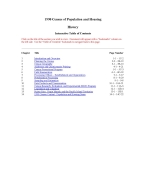1990 Census of Population and Housing—History
1990 Census of Population and Housing—History
Introduction
Describes in detail, through a series of separately published sections, most aspects of the 1990 census, from its early stages of research and planning through the tabulation, publication, and dissemination of the final results. Much of the detail has to do with the census process and procedures and how problems were resolved. Part A, for example, covers such topics as checking for broken type in printed questionnaires and leaving requests for appointments with residents not at home. However, this history at times goes beyond ‘‘how’’ into ‘‘why,’’ to picture the census in its place as part of our American social, economic, and political scene. Consequently, this series discusses, where appropriate, some of the forces—litigation, legislation, perceived user needs, public perception, budgetary contraints, and the like—that shaped the 1990 census and its outcome.
Part A. Chapter 4. Addressess and Questionnaire Printing; Chapter 6. Field Enumeration; Chapter 9. Sampling and Estimation.
Chapter 4 describes how the Census Bureau compiled the control lists for mailing and canvassing and oversaw the printing by contractors of several hundred million questionnaires.
Chapter 6 examines the logistics and personnel selection procedures, as well as the mailing and other census procedures. It discusses operations common to all district offices and also "special enumerations" in a variety of places, including American Indian reservations, ships, college dormitories, prisons, and others.
Chapter 9 discusses sampling, estimation and statistical weighting, and sampling variability.
Part B. Chapter 2. Planning the Census; Chapter 5. Census Promotional Program; Chapter 10. Data Products and Dissemination.
Chapter 2 describes the Census Bureau's efforts to solicit and integrate advice from data users on 1990 census data collection, questionnaire content, and data dissemination; the internal management and coordinating committees established to oversee census planning and operations; and the test census program that tried out and evaluated questionnaire design and content, data-collection procedures, outreach and promotion, data processing, geographic support, and data-product design and production.
Chapter 5 examines the agency's efforts to increase people's awareness of the decennial census's importance and to persuade them to participate voluntarily.
Chapter 10 discusses the 1990 census tabulation and publication program, the various data products and the media on which they were released, and the Bureau's user-training and data-dissemination programs.
Part C. Chapter 1. Introduction and Overview; Chapter 3. Census Geography; Chapter 7. Processing Offices Establishment and Organization; Chapter 8. Pretabulation Processing.
Chapter 1 summarizes the main components of the 1990 decennial census, from planning, preparation, and promotion to data collection, processing, and dissemination, and census-related litigation.
Chapter 3 discusses geographic preparations and support for the census, including the development and uses of the Topologically Integrated Geographic Encoding and Referencing (TIGER) System.
Chapter 7 describes the establishment, administrative functions, and closing of the Census Bureau's seven decennial census processing offices.
Chapter 8 reviews the coding, editing, data-processing, and related operations that took place in the processing offices.
Part D. Chapter 11. Census Research, Evaluation, and Experimental (REX) Program; Chapter 12. Legislation and Litigation; Chapter 13. Puerto Rico, Virgin Islands, and the Pacific Island Territories; Chapter 14. 1990 Census Content: Population and Housing Items; and Appendix A. 1990 Decennial Census Appropriations, Obligations, and Costs.
Chapter 11 describes the coverage-improvement projects, content- and coverage-evaluation programs (including the post-enumeration survey), the assessment of the decennial census outreach effort, and the quality assurance program.
Chapter 12 discusses decennial census related legislation enacted between 1983 and 1993, reviews the main components of several bills that did not become law, and summarizes the plaintiffs' and defendants' major arguments in the litigation spawned by the 1990 decennial census.
Chapter 13 examines the planning, outreach and promotion, data collection and processing, and publication programs of the 1990 census of Puerto Rico, the U.S. Virgin Islands, and the Pacific Island Territories.
Chapter 14 describes the population and housing questions asked in the 1990 census and summarizes the coding, editing, and allocation procedures for each question.
Others in Series
Publication
Publication
Publication




